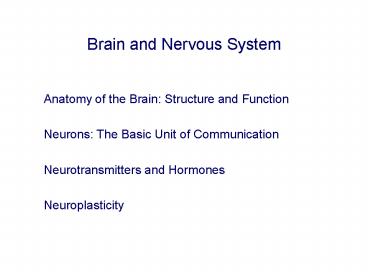Brain and Nervous System - PowerPoint PPT Presentation
Title:
Brain and Nervous System
Description:
Brain and Nervous System Anatomy of the Brain: Structure and Function Neurons: The Basic Unit of Communication Neurotransmitters and Hormones Neuroplasticity – PowerPoint PPT presentation
Number of Views:117
Avg rating:3.0/5.0
Title: Brain and Nervous System
1
Brain and Nervous System
- Anatomy of the Brain Structure and Function
- Neurons The Basic Unit of Communication
- Neurotransmitters and Hormones
- Neuroplasticity
2
Interdisciplinary Approach Neuroscience
- Begins with studying cells of the nervous system
- Neurons
- - up to one billion cells
- - inter-connections up to 50,000 per neuron
- Glia
- - outnumber neurons 101
- - function not incompletely understood
3
Studying the Nervous System
- Clinical observation
- Neuropsychology
4
Studying the Nervous System
- Experimental Techniques
5
Neuroimaging TechniquesUsed to examine
structures and functioning of brain
- Computerized Tomography (CT)
- Magnetic Resonance Imaging (MRI), functional MRI
(fMRI)
6
Neuroimaging techniques, contd.
- Positron Emission Tomography (PET)
- Electroencephalography (EEG)
7
(No Transcript)
8
(No Transcript)
9
(No Transcript)
10
The Nervous System
- Communication throughout the body
- Highly organized network
- Relays, processes, and integrates information
11
The Architecture of the Nervous System
12
(No Transcript)
13
(No Transcript)
14
(No Transcript)
15
(No Transcript)
16
(No Transcript)
17
(No Transcript)
18
Limbic System
- Involved in the regulation of motivational and
emotional states - Aggression, fear, anxiety, appetite
(stress-induced eating) - Kluver-Bucy Syndrome (Humans)
19
(No Transcript)
20
The Cerebral Cortex
21
Cortical Brain Structures
- 3 mm thickness millions of cells
- 80 of total brain volume
- Convoluted (folded) structure increases overall
amount of tissue (total area 1 sq metre) - Divided into 2 hemispheres and 4 paired lobes
frontal, temporal, occipital, parietal
22
(No Transcript)
23
(No Transcript)
24
Lateralization
- Two sides to the brain LEFT and RIGHT
hemispheres - Contralateral organization
- LEFT hemisphere controls actions of RIGHT side of
body - Most structures are bilateral
- Hemispheres connected through commissures
bundled neural fibers
25
(No Transcript)
26
Cerebral Commissures
- Tracts that connect the left and right cerebral
hemispheres - Example Corpus Callosum
27
(No Transcript)
28
Lateralization - Cerebral Asymmetry
29
(No Transcript)
30
(No Transcript)
31
(No Transcript)
32
Cortical Control of Sensory and Motor Information
- (Sensory and Motor Homunculus)
33
(No Transcript)
34
(No Transcript)
35
The Developing Nervous System
- Neurogenesis
- Differentiation among cells
- Proliferation of cells Migration
- Nearly complete by month 5 of uterine gestation
in humans - Connections among neurons and selective death of
neurons (Pruning/Wiring) - Can continue into adulthood.
36
(No Transcript)
37
The Neuron
- Characteristics of the Neuron
- Communication within the Neuron
- Communication between Neurons
38
(No Transcript)
39
(No Transcript)
40
Communication within the Neuron
- Distribution of charged particles ions
- Sodium Potassium
41
(No Transcript)
42
(No Transcript)
43
(No Transcript)
44
Communication within the Neuron
- Action Potential
- Momentary change from about -70 mV to 50 mV.
45
(No Transcript)
46
(No Transcript)
47
Communication between Neurons
- Neurotransmitters and Receptors
48
(No Transcript)
49
(No Transcript)
50
Endorphins, NPY, PYY, Urocortin, Substance P.
51
- Neurotransmitter vs Hormone
- Hormones are chemicals released by endocrine
- glands into blood circulation
52
- Some final thoughts on the CNS..
53
The Brain is PLASTIC































